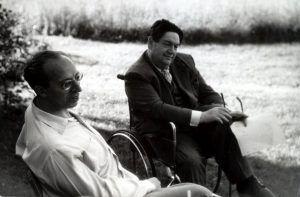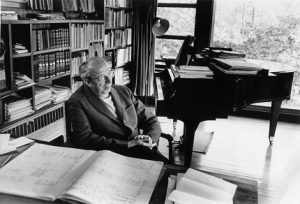The word “Tanglewood” still leaves the tingle of excitement in my chest it did when I was 15. It brings to mind dreams I once had of spending a summer with the Boston Symphony in a place to which admittance would truly mean I had made it. Little did I know that Tanglewood had been this pinnacle for quite some time, and Aaron Copland had played a great part in its notoriety. In this picture, Aaron Copland- the quintessentially American classical composer- sits with Darius Milhaud, a french composer of great notoriety who immigrated to America during WWII, in the place of a summer music festival that still has great musical notoriety today (Appold, photo). I would argue that this image is in many ways an accurate representation of American classical music because the figures in the image had so much influence from different musics in the Americas, and their relationship exemplified a similar musical relationship between their two respective countries. 
Copland was asked to work at “Berkshire Music Center at Tanglewood” for its first year in 1940 and “[continued] until 1965” (timeline). During that time, he composed many notable works such as the Tender Land Suites, Appalachian Spring, and Symphony No. 3 and won several awards to include the Pulitzer Prize, and an Academy Award (timeline). Copland’s dedication to Tanglewood is perhaps only comparable to Tanglewood’s dedication to his honor. From copious amounts of tribute programming, to the sculpture commissioned and installed in 2010, to the fact that his ashes were spread on the lawn of the Tappan House, one thing is made abundantly clear: America’s adamant patriotism made no exceptions for classical music (Shea).
Perhaps the only people more infatuated with American classical music, or American music in general, than Americans, were the French. In this image, Darius Milhaud sits during one of his summers teaching at Tanglewood. Copland idealized the man, and wrote only the highest of praise saying “if France, like England, had a composer laureate, the post would rightfully be his” (Copland). Milhaud, much like Copland,  was infatuated with music of South America (primarily Brazil) and their shared appropriation of such melodies could be described as inherently American. To suggest that American music has only positive defining factors would simply be false. Milhaud also used jazz and other forms of popular music very frequently in his compositions, and though he became renowned as a French composer, one could argue that his music is American because of all of the influences that he used and because much of it was in fact written here (Library of Congress). If Dvorak’s New World Symphony can be considered a work of American music, there is no reason that Milhaud’s couldn’t be on the same principle. Of course, it would be wrong to say that the music of these two composers could be accurately defined as American without acknowledging the shared trait of appropriating black and latinx ideas into something that became popularized by white composers. Unfortunately, this pattern could also be described as a shameful defining factor in American music.
was infatuated with music of South America (primarily Brazil) and their shared appropriation of such melodies could be described as inherently American. To suggest that American music has only positive defining factors would simply be false. Milhaud also used jazz and other forms of popular music very frequently in his compositions, and though he became renowned as a French composer, one could argue that his music is American because of all of the influences that he used and because much of it was in fact written here (Library of Congress). If Dvorak’s New World Symphony can be considered a work of American music, there is no reason that Milhaud’s couldn’t be on the same principle. Of course, it would be wrong to say that the music of these two composers could be accurately defined as American without acknowledging the shared trait of appropriating black and latinx ideas into something that became popularized by white composers. Unfortunately, this pattern could also be described as a shameful defining factor in American music.
Sources
Appold, Juliette. “Darius Milhaud and the Americas.” Darius Milhaud and the Americas | NLS Music Notes. Library of Congress, August 6, 2020. https://blogs.loc.gov/nls-music-notes/2020/08/darius-milhaud-and-the-americas/.
Boriskin, Michael. “Aaron Copland: Timeline of a Musical Life.” Aaron Copland / Timeline // Copland House …where America’s musical past and future meet. Copland House. Accessed November 7, 2022. http://www.coplandhouse.org/aaron-copland/timeline/.
Britannica, T. Editors of Encyclopaedia. “Darius Milhaud.” Encyclopedia Britannica, August 31, 2022. https://www.britannica.com/biography/Darius-Milhaud.
Copland, Aaron. “Music Out of Everywhere.” The New York Times. The New York Times, February 22, 1953. https://archive.nytimes.com/www.nytimes.com/books/99/03/14/specials/copland-milhaud.html.
Kraft, Victor. Aaron Copland with Darius Milhaud, Tanglewood. , . Photograph. https://www.loc.gov/item/copland.phot0004/.
Rothwell, Jessie. “The Dreams of Jacob (Darius Milhaud).” LA Phil. LA Phil. Accessed November 7, 2022. https://www.laphil.com/musicdb/pieces/729/the-dreams-of-jacob.
Shea, Andrea. “Aaron Copland Sculpture Makes Its Home at Tanglewood.” WBUR News. WBUR, June 30, 2011. https://www.wbur.org/news/2011/06/30/copland-sculpture.
